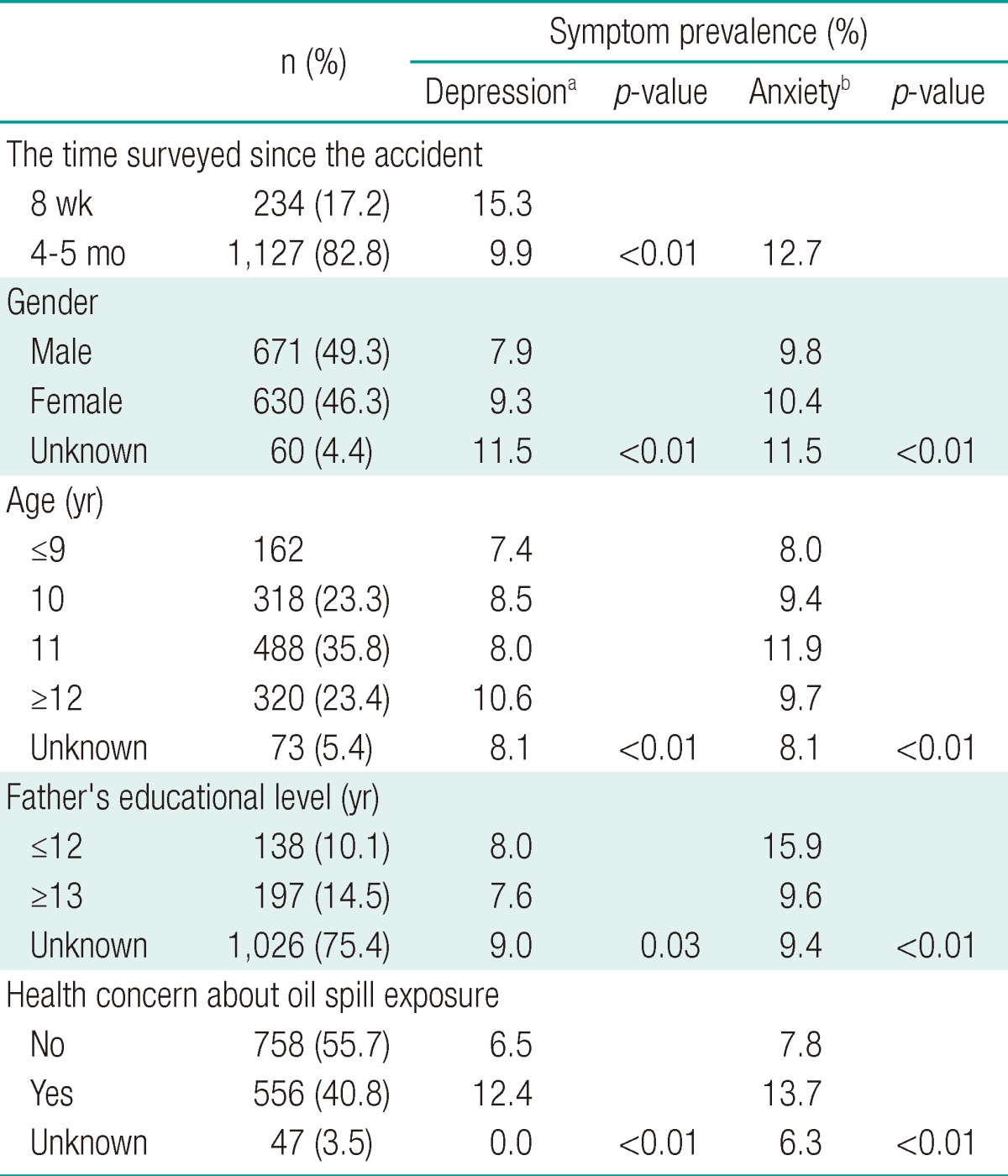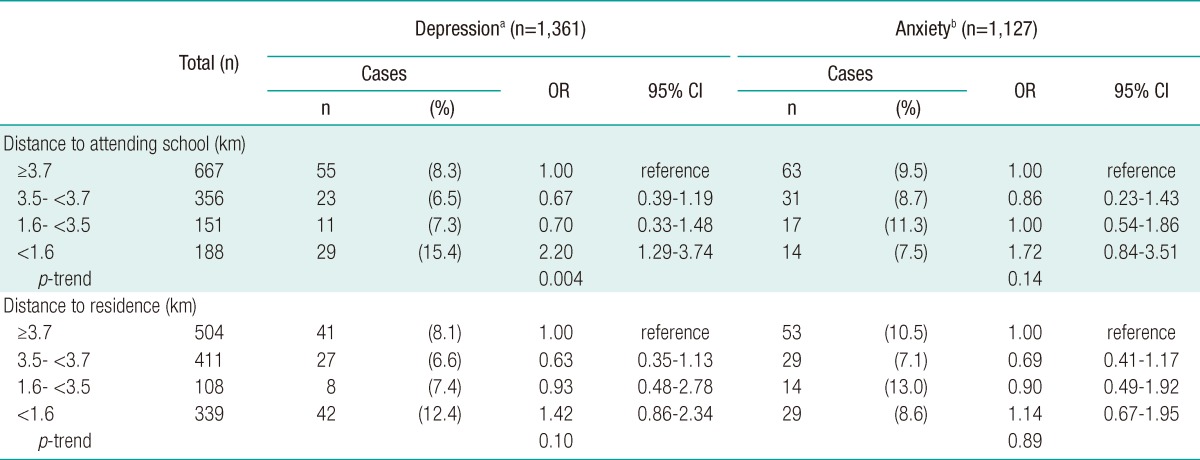Children's Mental Health in the Area Affected by the Hebei Spirit Oil Spill Accident
Article information
Abstract
Objectives
Children are one of the most vulnerable populations to the impact of disasters. We aimed to examine children's mental health in the area affected by the Hebei Spirit oil spill accident on December 7, 2007.
Methods
A cross-sectional questionnaire survey was conducted using the Korean versions of the Children's Depression Inventory and State Anxiety Inventory for Children on 1,362 children attending elementary schools in the affected area. The information on distances between the nearest contaminated coastline to the child's residential house or attending school were obtained using a web-based map by inputting two address points. The symptom risks of depression and state anxiety were estimated by multiple logistic regression analyses adjusted for age, gender, and other covariates.
Results
Children with the closest distance (in the fourth quartile) to the school from the contaminated coastline showed a significantly higher symptom risk of depression compared to those with the farthest distance (first quartile)(odds ratio, 2.73; 95% confidence interval, 1.40-5.33), while there was no significant association between anxiety symptoms and distance.
Conclusions
Children, a vulnerable population for mental health impact by the oil spill accident, should be included in mental health programs in the community along with their family as victims of the disaster.
Introduction
The biggest ever oil spill accident in Korea, the Hebei Spirit oil spill, happened in the sea near the west coastline of the Korean peninsula on December 7, 2007. The amount of spilled oil was more than 12,547 kL, and reached the western coastline with a spread of 1,052 km. Taean-gun, the most severely damaged region, is a densely populated coastal area where people have been heavily dependent on maritime activities.
Oil spills pose a complex mixture of chemical hazards which can be absorbed by the human body through diverse media including air, water, and seafood, and via multiple routes such as inhalation, ingestion, and skin contact. Furthermore, oil spill disasters induce socioeconomic disturbances, including enormous amounts of economic damage as well as a disruption to community bonds. Economic problems induced by oil spill accidents have caused psychological distress in communities [1]. Within one year after the Hebei Spirit oil spill, four local residents committed suicide, which shows that their sense of loss was multifaceted and deep-seated.
Studies on the Hebei Spirit oil spill accident have reported a general sense of stress and depression among a number of people in the affected area [2]. However, investigations on children in that area have not been conducted. We aimed to examine the mental health effects of the oil spill on children living in the affected area, where most of their families were victims of the accident.
Materials and Methods
Study Subjects
Two surveys (at eight weeks and four to five months post-accident) were conducted on children living in Taean-gun. By visiting 13 elementary schools that agreed to participate in the surveys (54.2% among a total of 24 elementary schools in Taeangun), we recruited a total of 1,467 elementary school students at baseline and asked them to respond to a questionnaire composed of questions about socio-demographic factors, address of their residence, and ratings on scales of depression and anxiety. As the ability of young children to answer the questions by themselves was a concern, only children in grades of 3 to 5 were recruited. Of the 1,467 children who responded to the questionnaire at baseline, 1,361 were included in the analyses after excluding incomplete or inappropriate responses.
The Institutional Review Board of Dankook University Hospital approved the study and written informed consent was obtained from the children's parents or guardians before their enrolment.
Measurement of Distance to the Nearest Contaminated Coastline
As a surrogate for the degree of impact of the oil spill in both chemico-physical and socio-economical aspects, we used the distance between the nearest contaminated coastline to the children's residence or to their school. To measure the distance, the addresses of the residence and school of each child were geocoded with the geographic information system using the Esri Arc-GIS Desktop version (Redlands, CA, USA).
Mental Health Assessment
We measured children's depression and anxiety symptoms using the Korean version of the Children's Depression Inventory (CDI) devised by Kovacs and Beck and the State-Trait Anxiety Inventory for Children (SAIC) devised by Spielberger, which have been validated and standardized [3, 4] among Korean children. The CDI is composed of 27 questions that are scored from 0 to 2. The summation of the scores for each question ranges from 0 to 54. In this study, the cut-off point of 22 or more was used to define depression. The SAIC has 20 questions that can be coded from 1 to 3. The summation of the scores for each question ranges from 20 to 60. The total score of 41 or more was defined as having anxiety in this study.
Confounding Factors or Covariates
Through administering the questionnaire to participating children, information on age (in years), gender, father's educational level (none, ≤elementary, middle and high, ≥college), and health concerns about exposure to crude oil (no, yes) was obtained. These variables, except for father's educational level, were included in the multivariate models to estimate the risk of depression and anxiety in association with distance from the contaminated coastline.
Statistical Analysis
The prevalence of depression and anxiety symptoms were calculated according to the general characteristics or covariates and tested for differences by using the Chi-square test. The risks of depression and anxiety in children were estimated using multiple logistic regression models adjusted for age, gender, survey time, and health concerns about exposure to crude oil. All analyses were performed using the SAS version 9.1 (SAS Inc., Cary, NC, USA) and the significance level was 0.05.
Results
About 84% of children in the study responded to the survey questionnaire. More than 75% of the information on their father's educational level was missing because the supervising teachers in participating schools did not want to include the question in the questionnaire. Children who showed a higher prevalence of depression and anxiety symptoms were more likely to be female, older, and concerned about the impact of the oil spill exposure on health (Table 1).

General characteristics and symptom prevalence of depression and anxiety in 1,361 children at baseline near area contaminated by the Hebei Spirit oil spill, Taean, Korea, 2008
The risk of depressive symptoms was significantly higher in children whose schools were closest to the nearest contaminated coastline compared to those farthest away; the odds ratio was 2.20 (95% confidence interval=1.29-3.74). The risk of depression symptoms increased significantly according to a decrease in distance from the nearest contaminated coastline to the children's attending school, with a dose-dependent response (p-trend=0.004), while there was no significant association between depressive symptoms and distance to the residence. Although the risk of anxiety symptoms showed an increase according to a decrease in distance to the school or residence, there was no statistical significance (Table 2).
Discussion
We found that the risk of depressive symptoms in children increased in areas that were contaminated by a high degree of oil spill, as measured by the distance from the contaminated coastline to their attending school as a surrogate, even after adjustment for potential confounders and covariates.
The prevalence level of depression in this area (10.3%) was much higher than in a Korean rural area (1.6%), but similar to the level in a noisy community where an air force base was located (11.7%) [5]. However, it is hard to disentangle the direct effect of exposure to the chemico-physical agents of hazardous crude oil on mental health and psychological consequences through the socio-economical damage by the oil spill accident.
Early life is a period of unique sensitivity with long lasting effects on mental health [6]. This study is the first to examine children's mental health in the area affected by an oil spill disaster. The initial heavy exposure to volatile organic compounds from the spilled crude oil may have neurological effects [7], including effects on affection and moods. However, the perceived threat rather than the disaster agent itself is deemed to be more important in children's post-disaster psychopathology [8]. Even though the oil spill accident itself did not accompany life-threatening features, its consequences due to socio-economic disruptions may have impacts on the mental and physical health of children.
Disasters may increase the risk of psychopathology in children because they may disrupt family functioning through causing psychopathology in the parents or disrupting the social network of the parents [9]. Incidents of adult suicide in the community immediately after the oil spill accident, as well as serious social conflicts aroused by the endless delay to compensation and parents' or caregivers' desperation, may increase the risk of depression and anxiety in children.
This study has limitations that need to be considered. As mentioned in the results section, we could not obtain information about the family's socio-economic status in 75% of the study population, which was initially planned to be acquired by the question about the father's educational level. In Korea, the parental educational level has been reported as a good variable to reflect familial socioeconomic position (SEP) in children [10]. Vulnerability and capacity to recover from disaster are usually dependent on the victim's SEP. Another limitation was that the study subjects did not include younger children below the 3rd grade of elementary school because we only included children who were considered capable of responding to the questionnaire by themselves. However, a previous review on children's mental health and disasters reported that it is important to ask children directly about their responses to disasters, regardless of disaster type, rather than relying on caregivers' assessments [11].
Children's mental health in the area affected by the Hebei Spirit oil spill accident was associated with the degree of the accident impact. A mental health program in the community should include children as well as their parents and family as victims of the disaster.
Acknowledgements
This study was financially supported by the Ministry of Environment, Korea. We would like to thank Ms. Seung-Min Lee and Eun-Jung Kim for their contribution to the data collection and management.
Notes
The authors have no conflicts of interest with the material presented in this paper.
This article is available from: http://e-eht.org/
